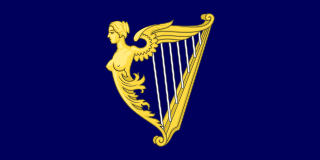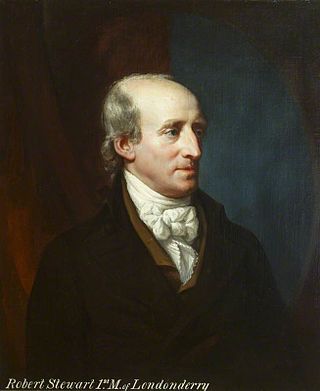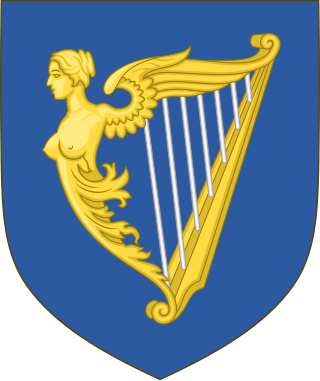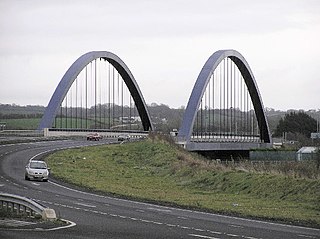Contents
| |||||
| Centuries: | |||||
|---|---|---|---|---|---|
| Decades: | |||||
| See also: | Other events of 1800 List of years in Ireland | ||||
Events from the year 1800 in Ireland.
| |||||
| Centuries: | |||||
|---|---|---|---|---|---|
| Decades: | |||||
| See also: | Other events of 1800 List of years in Ireland | ||||
Events from the year 1800 in Ireland.

Robert Stewart, 2nd Marquess of Londonderry,, usually known as Lord Castlereagh, derived from the courtesy title Viscount Castlereagh by which he was styled from 1796 to 1821, was a British statesman and politician. As secretary to the Viceroy of Ireland, he worked to suppress the Rebellion of 1798 and to secure passage in 1800 of the Irish Act of Union. As the Foreign Secretary of the United Kingdom from 1812, he was central to the management of the coalition that defeated Napoleon, and was British plenipotentiary at the Congress of Vienna. In the post-war government of Lord Liverpool, Castlereagh was seen to support harsh measures against agitation for reform. He killed himself while in office in 1822.

The Kingdom of Great Britain was a sovereign state in Western Europe from 1707 to the end of 1800. The state was created by the 1706 Treaty of Union and ratified by the Acts of Union 1707, which united the kingdoms of England and Scotland to form a single kingdom encompassing the whole island of Great Britain and its outlying islands, with the exception of the Isle of Man and the Channel Islands. The unitary state was governed by a single parliament at the Palace of Westminster, but distinct legal systems—English law and Scots law—remained in use.

The Acts of Union 1800 were parallel acts of the Parliament of Great Britain and the Parliament of Ireland which united the Kingdom of Great Britain and the Kingdom of Ireland to create the United Kingdom of Great Britain and Ireland. The acts came into force between 31 December 1800 and 1 January 1801, and the merged Parliament of the United Kingdom had its first meeting on 22 January 1801.

The Kingdom of Ireland was a monarchy on the island of Ireland that was a client state of England and then of Great Britain. It existed from 1542 to the end of 1800. It was ruled by the monarchs of England and then of Great Britain, and was administered from Dublin Castle by a viceroy appointed by the English king: the Lord Deputy of Ireland. Aside from brief periods, the state was dominated by the Protestant English minority. The Protestant Church of Ireland was the state church. The Parliament of Ireland was composed of Anglo-Irish nobles. From 1661, the administration controlled an Irish army. Although styled a kingdom, for most of its history it was, de facto, an English dependency. This status was enshrined in Poynings' Law and in the Declaratory Act of 1719.

Robert Stewart, 1st Marquess of LondonderryPC (Ire) (1739–1821), was a County Down landowner, Irish Volunteer, and member of the parliament who, exceptionally for an Ulster Scot and Presbyterian, rose within the ranks of Ireland's "Anglican Ascendancy." His success was fuelled by wealth acquired through judicious marriages, and by the advancing political career of his son, Viscount Castlereagh. In 1798 he gained notoriety for refusing to intercede on behalf of James Porter, his local Presbyterian minister, executed outside the Stewart demesne as a rebel.

John Jeffreys Pratt, 1st Marquess Camden,, styled Viscount Bayham from 1786 to 1794 and known as the 2nd Earl Camden from 1794 to 1812, was a British politician. He served as Lord Lieutenant of Ireland in the revolutionary years 1795 to 1798 and as Secretary of State for War and the Colonies between 1804 and 1805.

The Parliament of Ireland was the legislature of the Lordship of Ireland, and later the Kingdom of Ireland, from 1297 until the end of 1800. It was modelled on the Parliament of England and from 1537 comprised two chambers: the House of Commons and the House of Lords. The Lords were members of the Irish peerage and bishops. The Commons was directly elected, albeit on a very restricted franchise. Parliaments met at various places in Leinster and Munster, but latterly always in Dublin: in Christ Church Cathedral, Dublin Castle, Chichester House (1661–1727), the Blue Coat School (1729–31), and finally a purpose-built Parliament House on College Green.

The Irish Rebellion of 1798 was a popular insurrection against the British Crown in what was then the separate, but subordinate, Kingdom of Ireland. The main organising force was the Society of United Irishmen. First formed in Belfast by Presbyterians opposed to the landed Anglican establishment, the Society, despairing of reform, sought to secure a republic through a revolutionary union with the country's Catholic majority. The grievances of a rack-rented tenantry drove recruitment.

The Protestant Ascendancy, also known as the Ascendancy, was the political, economic, and social domination of Ireland between the 17th century and the early 20th century by a minority of landowners, Protestant clergy, and members of the professions, all members of the Established Church. The Ascendancy excluded other groups from politics and the elite, most numerous among them Roman Catholics but also members of the Presbyterian and other Protestant denominations, along with non-Christians such as Jews, until the Reform Acts (1832–1928).

John FitzGibbon, 1st Earl of Clare PC (Ire) was Attorney-General for Ireland from 1783 to 1789 and Lord Chancellor of Ireland from 1789 to 1802.
Roddy McCorley was an Irish nationalist from the civil parish of Duneane, County Antrim, Ireland. Following the publication of the Ethna Carbery poem bearing his name in 1902, where he is associated with events around the Battle of Antrim, he is alleged to have been a member of the United Irishmen and claimed as a participant in their rebellion of 1798.

The history of Ireland from 1691–1800 was marked by the dominance of the Protestant Ascendancy. These were Anglo-Irish families of the Anglican Church of Ireland, whose English ancestors had settled Ireland in the wake of its conquest by England and colonisation in the Plantations of Ireland, and had taken control of most of the land. Many were absentee landlords based in England, but others lived full-time in Ireland and increasingly identified as Irish.. During this time, Ireland was nominally an autonomous Kingdom with its own Parliament; in actuality it was a client state controlled by the King of Great Britain and supervised by his cabinet in London. The great majority of its population, Roman Catholics, were excluded from power and land ownership under the penal laws. The second-largest group, the Presbyterians in Ulster, owned land and businesses but could not vote and had no political power. The period begins with the defeat of the Catholic Jacobites in the Williamite War in Ireland in 1691 and ends with the Acts of Union 1800, which formally annexed Ireland in a United Kingdom from 1 January 1801 and dissolved the Irish Parliament.

Toome or Toomebridge is a small village and townland on the northwest corner of Lough Neagh in County Antrim, Northern Ireland. It lies in the civil parish of Duneane in the former barony of Toome Upper, and is in the Antrim and Newtownabbey Borough Council area. It had a population of 781 in the 2011 census.
Events from the year 1800 in Great Britain.
Events from the year 1798 in Ireland.
Isaac Corry FRS, PC (I), PC was an Irish and British Member of Parliament and lawyer.

Henry Boyle, 3rd Earl of Shannon, KP, PC (Ire), styled Viscount Boyle from 1764 until 1807, was an Anglo-Irish politician and peer who was one of the last surviving members of the Parliament of Ireland. He represented County Cork in the Parliament of the United Kingdom from 1801 to 1807. He then briefly served as Member of Parliament for Bandon in 1807, succeeding as Earl of Shannon later in the same year. He served as Custos rotulorum for County Cork from 1807 to his death. He was the first Lord Lieutenant of Cork from 1831 to his death.

British General Charles Cornwallis, the 1st Marquess Cornwallis was appointed in June 1798 to serve as both Lord Lieutenant of Ireland and Commander-in-Chief of Ireland, the highest civil and military posts in the Kingdom of Ireland. He held these offices until 1801.

Frances Stewart, 1st Marchioness of Londonderry (1751–1833), was mistress of a large landed and politically connected household in late Georgian Ireland. From her husband's mansion at Mount Stewart, County Down, in the 1790s her circle of friends and acquaintances extended to figures engaged in the democratic politics of the United Irishmen. Correspondence with her stepson, Robert Stewart, Viscount Castlereagh, and with the English peer and politician John Petty, record major political and social developments of her era.